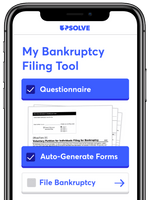Why you should not include credit card or personal loan debt payments in Schedule J (Expenses)
2 minute read • Upsolve is a nonprofit that helps you get out of debt with education and free debt relief tools, like our bankruptcy filing tool. Think TurboTax for bankruptcy. Get free education, customer support, and community. Featured in Forbes 4x and funded by institutions like Harvard University so we'll never ask you for a credit card. Explore our free tool
Since Schedule J is essentially a budget for life after bankruptcy and since you will not continue to pay your debts after filing for bankruptcy, don’t list your monthly credit card payments etc. on your Schedule J. Anything that gets discharged in your case, that you won’t continue to pay for should be left off your Schedule J.
Written by Attorney Karra Kingston.
Updated August 15, 2023
If you are filing for bankruptcy, you will need to disclose your income and expenses to the Bankruptcy Court. Official Form 106I (Schedule I) is the form where you disclose your monthly household income. Official Form 106J (Schedule J) is the form where you disclose your current household monthly expenses. At the end of Schedule J, you will subtract your income from your expenses. This lets the Bankruptcy Court and the Trustee know whether you have too much disposable income to qualify for a Chapter 7 bankruptcy. Too much disposable income is when you have a significant amount of money left over after paying your expenses. If someone has a sizeable amount of money left after paying their living expenses, it would not be fair that their creditors don’t get paid. That’s why a high disposable income at the end of Schedule J is a signal to the Court that maybe the filer should be in a Chapter 13 bankruptcy instead.
Expenses that are not listed on Schedule J
Since Schedule J is essentially a budget for life after bankruptcy and since you will not continue to pay your debts after filing for bankruptcy, don’t list your monthly credit card payments etc. on your Schedule J. Anything that gets discharged in your case, that you won’t continue to pay for should be left off your Schedule J. This includes credit cards, medical debts, payday loans etc. A good way of looking at this might be to compare your monthly payments to your list of unsecured debts on your Official Form 106E/F (Schedule E/F). All of your unsecured debts have to be listed there. You should not have a monthly expense listed on Schedule J for a debt that is listed on your Schedule E/F.
There are two exceptions to this rule:
(1) If you have non-dischargeable debts, such as child support or recent tax debts that you will continue to make payments on, make sure to list these payments on your Schedule J.
(2) If you have a car loan or lease and you want to keep the vehicle, you should include the monthly payment in your expenses. After all, it will continue to be an expense you have to pay each month.
Upsolve Member Experiences
1,997+ Members OnlineExpenses that are listed on Schedule J
Some of the monthly expenses that are listed on your Schedule J include your rent or mortgage payments, upkeep expenses on your home, utilities, food, gas, telephone, water, car maintenance, childcare, clothing, laundry, and vehicle maintenance. Basically, the money you spend just to live each month is listed here. Review your expenses thoroughly to make sure that you have not missed any. If you see that you have too much income left over after excluding your debt payments, then you should go over your list of monthly expenses again. Perhaps, you may have missed an expense that only happens once a year. For example, if you bought new tires in January, you should spread out the payment over the twelve months.
Most people who file Chapter 7 bankruptcy, don’t have enough income left over each month for their daily living expenses. If after revisiting your monthly expenses you still have a lot of money left over, consider speaking with a bankruptcy lawyer to go over your options. A bankruptcy lawyer can review your expenses to make sure that you have not missed any important expenses. They will also be able to tell you if Chapter 13 may be a better option for you.
Conclusion
Filling out Schedule J can seem complicated but if you go through your expenses carefully you should have no problem. Just remember, only list expenses you will have even after your bankruptcy is done, and don’t forget to include those big expenses that only come up every so often. If you are looking to file Chapter 7 bankruptcy and would like some help with your forms, see if you’re eligible to get help from Upsolve. Upsolve is a non-profit organization that has many tools that can help you fill out your bankruptcy forms for free.












